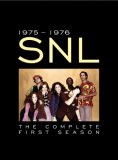| Reviews & Columns |
|
Reviews DVD TV on DVD Blu-ray 4K UHD International DVDs In Theaters Reviews by Studio Video Games Features Collector Series DVDs Easter Egg Database Interviews DVD Talk Radio Feature Articles Columns Anime Talk DVD Savant Horror DVDs The M.O.D. Squad Art House HD Talk Silent DVD
|
DVD Talk Forum |
|
|
| Resources |
|
DVD Price Search Customer Service #'s RCE Info Links |
|
Columns
|
|
|
Saturday Night Live - The Complete First Season
The beginning, as you probably don't remember it
Reviewer's Bias*
Loves: Sketch comedy
Likes: SNL, Gilda Radner
Dislikes: Blind worship of the early years
Hates: Those short films
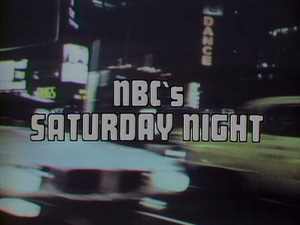 The Show
The Show
An old coot named Henry David Thoreau once said "Every generation laughs at the old fashions, but follows religiously the new." Old Hank never watched early "SNL" episodes it seems, since there's little laughter to be had by younger viewers, who certainly don't follow the current show religiously. If anything, they'd slag both versions equally, if they ever saw the original episodes. Now, they have just that opportunity.
Lorne Michaels obviously didn't invent sketch comedy with "SNL," but he gave it a new relevance by appealing to younger viewers, combining subversive and frequently high-concept segments with popular music and whatever else was laying around to create a late-night viewing destination. Back then, the show had a real "for us, by us" feel, one the current show can only hope to achieve thanks to its status as an institution. It's hard to be the counter-culture when you're part of a multinational corporation, are the basis of two current TV series, and have established yourself as a breeding ground for bad catchphrase-based movies.
Back when "Saturday Night Live" started, there was no corporate polish to the show. In fact, it wasn't even "Saturday Night Live," as the title was "NBC's Saturday Night" for the first season. The whole effort had the feel of a college humor magazine, with jokes only a degree-holder could get, lots of drug comedy and plenty of commercial parodies, all done with a rough edge that suggested an underground effort, even if it was shown on one of the big three networks. Its appeal to people up at 11:30 on a Saturday, probably high as a kite, was undeniable, and it continues to appeal to that same audience today. Things tend to be a bit funnier when you're really tired.
The series' cast, a gaggle of seven comedians who made history as The Not Quite Ready for Prime Time Players, are funny people, but here they were unable to find their mark, though John Belushi and Gilda Radner, due to their unique personalities, at least make you smile. It's painful to watch them struggle through these episodes, battling poor pacing and incomplete concepts in search of laughs. Frequently a sketch will just make you want to get off the couch and walk around, uncomfortable in watching them flounder. Of course, they were trying to figure out how to make this series work and probably coping with hefty drug habits if the book Live from New York is to be believed, but that doesn't excuse these episodes' weak jokes.
There are a number of memorable scenes in this set, especially during the seventh episode, hosted by Richard Pryor. The guest host has always been a big part of whether an episode works or not, and Pryor hits it out of the park, taking part in one of the best of Belushi's samurai sketches, and a hilarious word-association exercise with Chevy Chase. The tone and subject matter is noticeably more aggressive and subversive in this episode, showing Pryor's impact on the series. The influence of the host comes across clearly during appearances by Peter Cook and Dudley Moore, Dick Cavett and Madeline Kahn. Sketches like the New York City version of "Our Town" done by Cavett, Kahn's great riffing with Radner in "Not for Ladies Only," and the Cook/Moore sketches that left out the show's cast, prove that a good host is a valuable addition to an episode. If they didn't, the lesser lights like Gerald Ford press secretary's Ron Nessen certainly does.
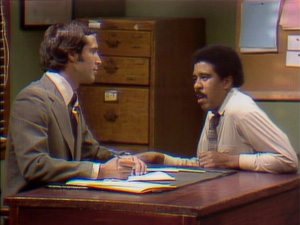 One host in particular needs to be watched, but not for any positive reasons. In an episode rarely seen since its original broadcast, "Mary Hartman, Mary Hartman" star Louise Lasser stumbles through an embarrassingly bad collection of sketches. Reportedly, she was having personal problems and refused to do any scenes with anyone by Chase, and, if true, her troubles are obvious, especially during her bizarre monologue. Though the camera set-up is obviously planned, one has to wonder how much of the performance was scripted and how much of it is on-screen breakdown. There's a filmed scene in here, about a break-up in a diner, that is so bad and so overdone that it might be the worst segment ever shown on "SNL." We also get the season finale, hosted by Kris Kristofferson, during which he was reportedly blind drunk. It's fun to try to look for proof in his sketches, but if he is, he's an impressively functional drunk.
One host in particular needs to be watched, but not for any positive reasons. In an episode rarely seen since its original broadcast, "Mary Hartman, Mary Hartman" star Louise Lasser stumbles through an embarrassingly bad collection of sketches. Reportedly, she was having personal problems and refused to do any scenes with anyone by Chase, and, if true, her troubles are obvious, especially during her bizarre monologue. Though the camera set-up is obviously planned, one has to wonder how much of the performance was scripted and how much of it is on-screen breakdown. There's a filmed scene in here, about a break-up in a diner, that is so bad and so overdone that it might be the worst segment ever shown on "SNL." We also get the season finale, hosted by Kris Kristofferson, during which he was reportedly blind drunk. It's fun to try to look for proof in his sketches, but if he is, he's an impressively functional drunk.
Though the show's first season is spotty in terms of the quality, making Andy Kaufman's unusual appearances stand out, one area that tends to work rather consistently is Chase's time behind the desk of the Weekend Update segment, setting the stage for 32 years of current-event comedy. Sure, the jokes are a bit stale 31 years later, including the now legendary running Francisco Franco gags, but the concept was solid, Radner's appearances as hearing-impaired Emily Litella were hysterical and Chase had the smarmy delivery needed to properly parody evening news anchors. Even Laraine Newman, the least utilized member of the cast, was good in these bits, using a dead-on uber-serious reporter's voice that really sold her on-the-scene stories. It was certainly Chase's shining moment on the series, as his pratfall cold opens were predictable and awful even then, working only when poking fun at President Gerald Ford, and working best during Buck Henry's first guest hosting duties, in which Garrett Morris and Belushi get in on the slapstick.
Though comedy has always been the focus on "SNL," the music has often been the reason people tune in, hoping to catch a unique live performance by one of their favorite bands or an up-and-coming act. The first season set the standard, despite a lack of superstars in the line-up. The second episode turned over a good chunk of time to music, including a reunion by Paul Simon and Art Garfunkel, and followed it up with an unforgettable performance by Joe Cocker, via Belushi, in the third show. Though there were plenty of well-known pop stars on the show, including a lipsynching Abba, a pre-recorded (and nervous) Carly Simon (backed by Newman and Chase), and an excellent Billy Preston, the show frequently went to the fringes of mainstream music, pulling in acts like Loudon Wainwright III, a jazzy Toni Basil (pre-"Hey, Mickey") and great singers like Gil Scott-Heron and Jimmy Cliff. Sure, the show dipped into an odd act once or twice, like Anne Murray, Howard Shore's All-Nurse Band (with Lily Tomlin on vocals) or the entertaining but out-of-place Desi Arnaz, but you generally knew you were getting something interesting.
The good parts of the series' first volley are frequently overshadowed by the more questionable parts of the first year of SNL, and they aren't just questionable in hindsight. The short films shown throughout the season were perfect examples of "good concept, poor execution." Instead of taking ideas like trying to find the funniest person in Irvington, New York or letting a tailor and plastic surgeon comment on each other, and making funny, conceptual shorts, the show ended up with boring blocks of content that killed any momentum the sketches created. Albert Brooks was involved with several of these, but his humor is not close to the level of his feature films. These movies eventually lead to the show requesting home movies from the audience, some of which were better than the series' material.
That's not that hard considering some of the bits the show put out each episode. The faux surreal bees sketches, which put people in bee suits in any number of situations are beyond pointless, but are fondly remembered for some odd reason. Pointless and forgotten describes the variety acts the show brought onto the show, including The Shapiro Sisters, three dancing, lipsynching pre-teen girls without an ounce of comedy between them. Thankfully the show doesn't resort to such time-filler these days (for the most part.)
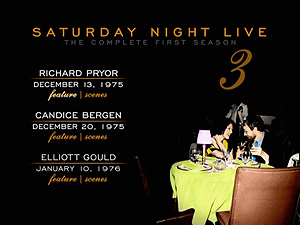 Of all the show's weaker material, the most egregious mis-step has to be the regular appearances of muppets from Jim Henson's workshop. These weren't the warm and fuzzy muppets like Kermit and Fozzie Bear. They were creepy monsters from the "Land of Gorch," who acted out adult situations, including one sketch about "marital aids." They were consistently slow and unfunny, and worse yet, they were lengthy, bringing each episode to a screeching halt. While the idea of muppets talking dirty is amusing, it only works if they look like adorable Elmo clones, not rejects from "Fraggle Rock." See "Avenue Q" if you need proof.
Of all the show's weaker material, the most egregious mis-step has to be the regular appearances of muppets from Jim Henson's workshop. These weren't the warm and fuzzy muppets like Kermit and Fozzie Bear. They were creepy monsters from the "Land of Gorch," who acted out adult situations, including one sketch about "marital aids." They were consistently slow and unfunny, and worse yet, they were lengthy, bringing each episode to a screeching halt. While the idea of muppets talking dirty is amusing, it only works if they look like adorable Elmo clones, not rejects from "Fraggle Rock." See "Avenue Q" if you need proof.
Though the show is rather lacking is laughs in the first season, there are at least three good reasons to watch this set if the comedy or music doesn't do it for you. One, the evolution of the show is interesting to watch, in little touches, like the changes in the opening credits, to the development of institutions like the monologue. Two, the many references to then-current events and pop culture give those without knowledge of the time a chance to learn something new. I had no idea who Nessen was until I saw his guest host spot on the show and googled him. The final reason is the chance to see these shows in their original format. Sure, that means sitting through some real crap, but the experience of seeing the show as it was meant to be seen is easily worth it.
The DVDs
The packaging on these DVDs is undeniably impressive, and the type any "SNL" fan would love to have 32 of on their shelves. Nearly two inches deep, the case looks like a leather-bound book with classy, subdued graphics. Thankfully, the promo information on the back is printed on a removable sheet, letting the set look like the keepsake it should be. Open the box like a book, and you see a stylish cast photo on a thick inner plate that holds the box closed. In a well on the right side sits the four-panel digipak which holds the eight DVDs, two overlapped discs per tray. The digipak also has episode information and a set overview. Also in the box is a 32-page booklet pf photos. Captions, or more preferably essays, would have been welcome, but it's a nice bonus either way. The entire set maintains a consistent, attractive and substantial feel that befits such a DVD collection.
The DVDs, which have disc art of images from the season's opening credits, feature static, full-frame main menus, following animated intros. The menus offer a choice to play each episode or select scenes, and special features on Disc Eight. There are no audio options, and, despite what the box says, there are no subtitles or closed captioning either. It's worth noting that it seems, with the exception of the final segment, that the bumper screens after commercials (to which Pryor makes reference to) have not been included.
The Quality
If you've watched these episodes in syndication, you have an idea of what this show looks like. Dull color, an overall soft image, smearing and some noise is evident throughout the set, with the films shown during the show looking worse, with additional noise, a softer image, and defects like wash-outs and undersaturated colors. Foreign objects are obvious throughout the set, in the form of fibers and dirt and some odd slowdowns in the video that I can't quite explain. The show is certainly watchable, and looks better than it has before, with a cleaner image and a higher resolution, but it is what it is: old.
The sound is simple, presented as Dolby Digital 2.0 tracks which are clean and relatively distortion free. The quality is relative to the recording of the episode, some of which sound tinny and weak, while others are robust and powerful.
The Extras
The inclusion of audition tapes on recent SNL DVDs has been great, as they reveal just why the talent was selected to join the cast, and show early versions of their characters. Here, they make me wonder if there were more than seven people auditioning for the show, because if there was, there had to be someone with a better screen tests than the seven included here. These rambling auditions seem to amuse the people off-camera (apparently the other cast members), but they don't begin to hint that these actors are funny, as they focus more on imitations and accents than characters and comedy. No matter the level of comedy, they are great as historical documents.
Also included is an interview from Tom Snyder's "Tomorrow Show," with Lorne Michaels and the cast. This short chat (less than five minutes long) was a promo for the then-upcoming series premiere.
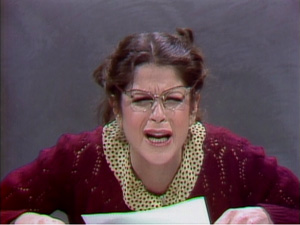 It's amazing that they couldn't sit down someone for a commentary track or two, to give some context to the episodes. There's really no effort to analyze the series, no retrospective content and not enough of the found materials that make sets like these so interesting. Perhaps the whole DVD budget went toward paying the music bill. Either way, it's disappointing.
It's amazing that they couldn't sit down someone for a commentary track or two, to give some context to the episodes. There's really no effort to analyze the series, no retrospective content and not enough of the found materials that make sets like these so interesting. Perhaps the whole DVD budget went toward paying the music bill. Either way, it's disappointing.
The Bottom Line
It seemed like we'd never get to see these shows released in complete season sets, and now that it's happened, new generations can learn that the show was never 90 minutes of unmitigated genius, and cherry pick the inspired sketches and great musical moments. This is the legend, warts and all, which means seeing the lesser segments that memory has fuzzed out over the years. While the packaging is beautiful and the presentation is as good as one could expect, the extras are way too limited for such a milestone release. Fans of "SNL"'s early years will consider this a must own, but more recent viewers will be satisfied, and perhaps frustrated, by a rental of this historic release.
Francis Rizzo III is a native Long Islander, where he works in academia. In his spare time, he enjoys watching hockey, writing and spending time with his wife, daughter and puppy.Follow him on Twitter
*The Reviewer's Bias section is an attempt to help readers use the review to its best effect. By knowing where the reviewer's biases lie on the film's subject matter, one can read the review with the right mindset.
|
| Popular Reviews |
| Sponsored Links |
|
|
| Sponsored Links |
|
|
| Release List | Reviews | Shop | Newsletter | Forum | DVD Giveaways | Blu-Ray | Advertise |
|
Copyright 2024 DVDTalk.com All Rights Reserved. Legal Info, Privacy Policy, Terms of Use,
Manage Preferences,
Your Privacy Choices | |||||||









